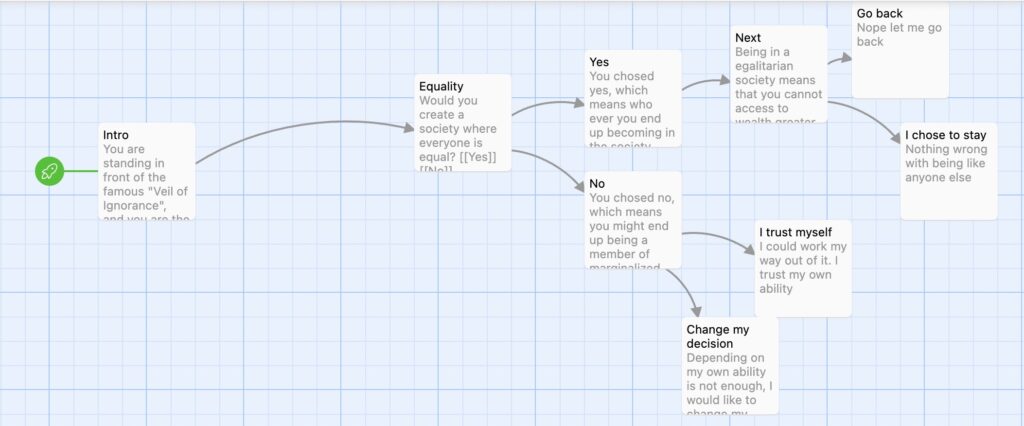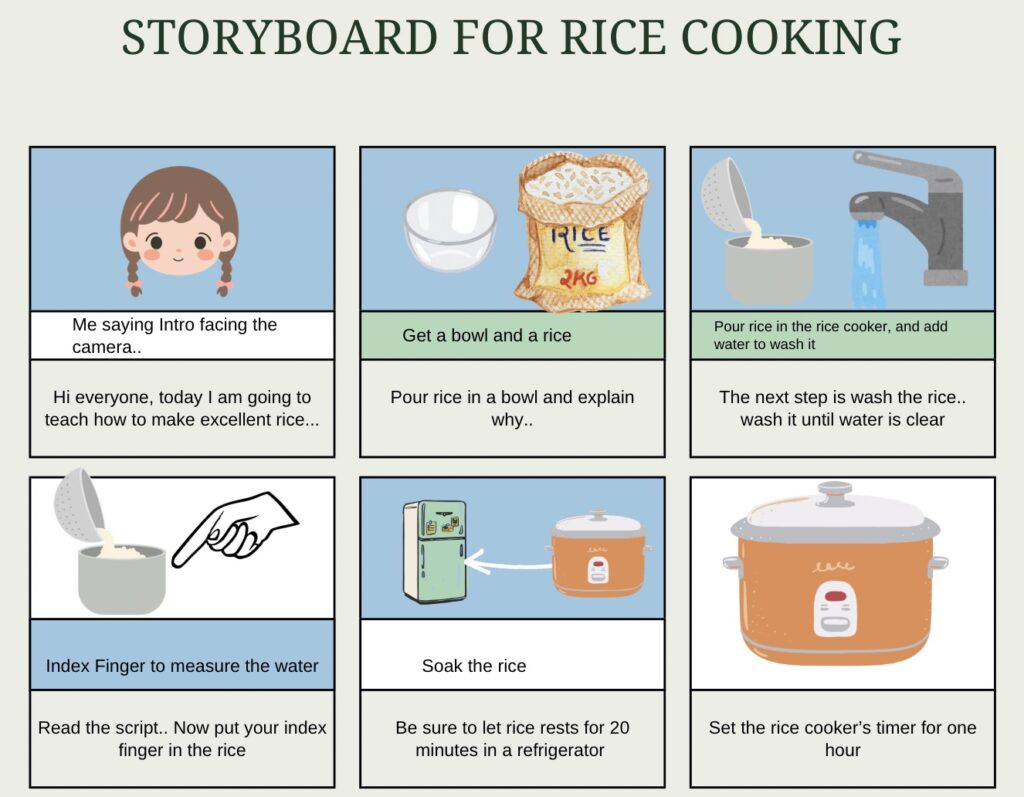What learning experience does a branched narrative like Twine provide for learners? Where else do you come across branched narratives?
Twine Experience
I had a lot of fun creating a Twine story, although it was quite confusing at the beginning.
I think what is different about writing stories on Twine is that it makes me think about the “next action” ahead of time. For example, as I am writing about creating an equal society, I need to think about what happens when the society is unequal. What kinds of decision or rationality might be involved if the reader chose to create an unequal society.
My inspiration of the Twine story is from John Rawls’ Veil of Ignorance. I first learned it in a TikTok video that talks about gender equality, and it stays with me ever since. I think it would be interesting to create a story where reader put themselves in an original position and think about what does equality means.

Intro

First choice

Then it leads to..

I then give a second scenario for viewers to think about their decision

Clicking Go Back would be:

It means that “you” don’t want to live in an equal society anymore
Clicking stay means:

If you chose “No” originally:

Click “I trust myself” would lead to:

Click “Change my decision” would lead to

Overall, after I played with Twine, I can understand why this is often used by game developers. This experience actually reminds me of a lot of playing PS5 games such as It Takes Two, I remember I also have the option to chose my next action, and I have no idea what that actions would lead me to. This reveals that game developers have to think about all the possible actions, and Twine is a great platform for that because they can have a bird eye view on the whole game.
Moreover, I think Twine could also be a good fit for Educational storytelling. I think we may able to experiment with it, developing a story for a concept that needs to be studied. For example, “Veil of Ignorance” could be one. I develop a story based on one concept. This means that we can also develop a story based on “UDL” or even “Backward Design”. The learning experience that a branched narrative provide for the learners is that learners can actively think about their decisions and how concepts are interrelated.
What was the experience like capturing video away from the screencast? What did you find challenging and what was easier for you? What would you do differently next time?
Below is my video for a learning purpose. My topic is rice cooking. The experience of capturing video away from the screencast is sooo HARD. I used my phone to film the whole video, so you may see the screen is very shaky. It’s hard to hold one phone and then do other things (eg. holding the bowl, open up the tap) at the same time, so please bear with me, I am truly sorry for this!
RICE COOKING TUTORIAL
I noticed that another challenge is my audio, which seems not always loud and clear. Thus, I did two things to compensate it. First, I added subtitles. The subtitles are auto-generated, so some words might be off. I added subtitles and also some text to point directions in case my viewers can’t hear me or do not know where to look at.
Secondly, I repeated the steps. I articulated some of the steps twice, one when I explain the step for the first time, second when I am actually doing the step. I did this because I want to make sure my viewers/learners are following. I do have the experience where when an instruction was only articulated once, I forgot immediately. Thus, I want to provide repetition for my learners.
Below is my script:
Script
Hello Everyone! Today, I am going to show you how to cook excellent rice. Rice is important to many Asian cultures, including Chinese. One of my Canadian friends was invited to my house for dinner, and she showed great interest in how I make rice. For example, she saw me not using any measurement for how much raw rice I should be using for dinner of 6 people. She also asked me how I am able to figure out how much water to add depending on the portion of rice. Therefore, I think it would be a good idea to do a tutorial on how to make rice. Make sure you have a bowl, one bag of rice, a rice cooker or a pot, and water. This is the big reveal of the mystery of rice, let’s begin!
Let’s say we are serving two people for dinner. Now how much rice do we need? The correct answer is just one. This is because a 100g of rice will double its size and become 200g after fully cooked. I did not make this up, I checked with other Chinese! This tells us that the size of rice will always double. So if only two people is having dinner, and each of them is having one bowl of rice, then the raw rice should only be one bowl.
The next step is to wash the rice. You can see how the water becomes white when we wash the rice for the first time. We need to do this three times or even more. When we see the water becomes clear, it is ready. The purpose of washing rice is to make sure the rice won’t stick together when it is cooked.
Then, we could finally add the water that is actually used in cooking. No measuring cup, no bowl, no anything. Here’s the genius way of figuring out how much water we should add, which is to put your index finger in the rice and then see if the water reaches to the first line of your index finger. No matter how much rice you want to cook, your index finger is your measuring cup. We always stop at the first line of our index finger.
Now we need to let the rice rest for 20 minutes in the refrigerator. The reason for this step is to let rice absorb as much water as it can, so that we won’t be having dry rice.
The final step is to cook the rice. If you have a rice cooker, just put the rice in and start the timer for one hour. If you don’t have rice cooker, you can still repeat the above step in a cooking pot. Then boil the water with rice in it, when the rice is boiled, turn down the heat to medium heat. Cook for another 15 minutes, use a fork or any other objects to stir the rice every once in a while. I would say probably every 5 minutes! This is to avoid cooked rice to stick in the bottom of the pot. I hope you guys like this tutorial and is ready to make rice! Thank you very much.
More reflections on video creation:
I think script is useful in helping me organize my content. However, in the actual production process, I tend to have some “extra” words to say. Nevertheless, scripts still give me the backbone of the content.
Simple Storyboard:

I used Canva to create my storyboard because the last module gave me a good experience with it (also because I am not a good painter…). Canva also offers lots of free graphics to use, and I am able to find all the graphic I need.
I think the storyboard as well as the script are very helpful in my video creation process. I can refer to what the next step is, and when I was editing my video, I also looked at them as my reference.
A great module learning experience! In the future, the thing I would do differently is that I want to buy a phone holder. Also a mini mic and attach to my clothes. I think my filming technique might have increased extraneous load for my viewers/learners, which is not good.